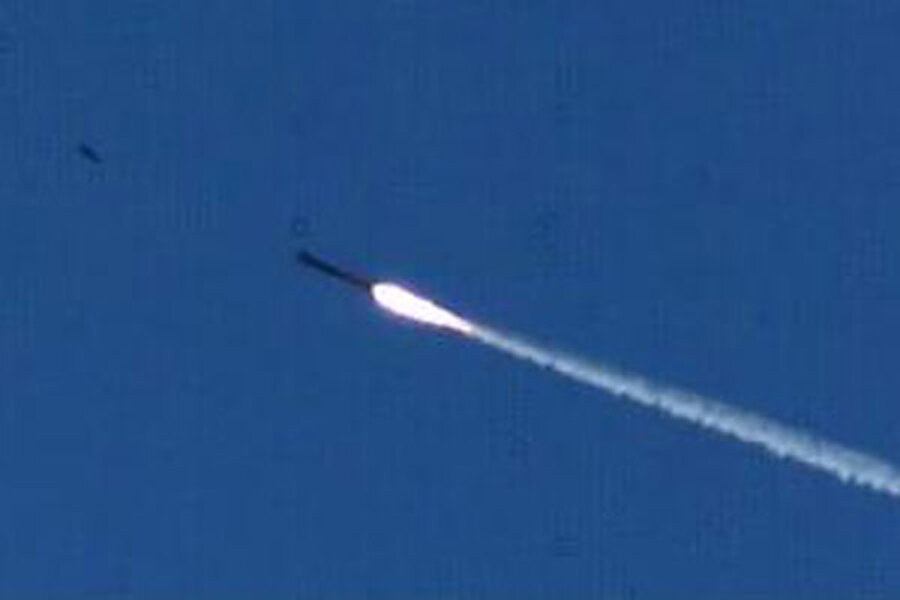Israel successfully tests Iron Dome missile shield
Loading...
| Jerusalem
Israel tested the use of its new Iron Dome antimissile system several times over the past few days, boosting the likelihood that it can neutralize or severely weaken the ability of Hamas and Hezbollah to launch successful missile strikes at the Jewish state.
In recent days, the short-range missile defense system that has been developed over the past 2-1/2 years by Rafael Advanced Defense Systems, a government-owned company, has been successfully tested against Qassam rockets, Grad rockets, and mortar shells. The system is expected to be fully operational in May.
But after Israel announced the successful tests on Wednesday, Hamas in Gaza appeared to answer on Thursday with a round of mortar fire from the Gaza Strip. At least 10 mortar shells hit Israel on Thursday.
The Iron Dome is designed to target the weapons of Israel's most significant regional enemies. These include Hamas's mortar shells and Qassam rockets, Hezbollah's Katyusha rockets, and even Iranian Fajr rockets, some of which Israel says have been smuggled into the Gaza Strip, according to Haaretz newspaper. The program is part of an improved, multilayered defense system that Israel has been developing over the past decade. This includes the Arrow system for long-range ballistic missiles and a still-under-construction medium-range system called Magic Wand.
How it works
One of the advantages of the Iron Dome system is that it can distinguish worthwhile targets - missiles headed for a populated area – from those destined to land in an open field, for example, and not worth trying to knock out of the sky. In wartime, such a tool could be crucial. During Israel's war with Lebanon in the summer of 2006, more than 4,000 Katyusha rockets were fired into Israeli territory.
The system has radar detection systems that Rafael says quickly pick up missile launches, transmit data to a computerized launch system, and can then quickly determine if a missile should be launched to intercept the rocket. "If the estimated rocket trajectory poses a critical threat, a command is given within seconds and an interceptor is launched," the company writes. The interceptors themselves are maneuverable and have radars of their own to guide them to the target."
Shorter-range missiles have become an ongoing threat to Israeli security, and were the ostensible reason Israel launched its war against Hamas in Gaza in late 2008. While past defense systems focused on long-range missiles, shorter-range missiles were deemed harder to hit because they take off and land so quickly.
But the Iron Dome can neutralize rockets with a range between 2.5 miles and 50 miles. That would cover most of the rockets that can be fired from Gaza into Israel, as well as those from southern Lebanon.
"For the first time, Iron Dome faced multiple threats simultaneously. All the threats were intercepted with complete success," a statement from Israel's Defense Ministry said.
To be sure, the system comes at a cost. Rafael has estimated that it will cost about $50,000 to shoot down an incoming rocket from the Gaza Strip, while Gaza rocket makers say they can make crude Qassam rockets for as little as $200.
Strategic shift
Analysts say that the new system offers a major strategic shift in how Israel can approach the missile threat.
"It's a fundamental change in the situation in a very broad sense," says Uzi Rubin, of Rubincon Defense Consulting. "With the Qassams, Katyushas, and Sajjils, we were sitting ducks. They could fire at an Israeli city and cause no small amount of mayhem," Rubin says.
Until around 2001, longer-range missiles from Iraq or Iran were considered to be the primary threat, and the main tool was an early-warning system, which sent off sirens telling people to hurry into bomb shelters. "That's passive defense, which just aims to minimize fatalities. But this is a move from total helplessness to active defense," Rubin adds.
Nonetheless, Rubin doesn't expect that it will change the dynamics of conflict. "Hamas will still try to shoot rockets of various ranges at Israel. This is an ongoing war – they'll find other means to fight us," he says. "But from their point of view, it will rob them of the ability to inflict easy casualties."





